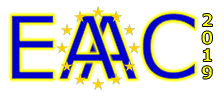Speaker
Description
The efficiency of electron bunch acceleration by wakefield, excited in two-beam electron-positron dielectric resonator collider by train of electron bunches is determined by transformer ratio [1-14]. Two trains are considered. First is train of homogeneous bunches, current grows linearly along a train. Current of the second train grows linearly along each bunch and train. The length of homogeneous bunch equals to half of wavelength λ/2. In 2nd case a short bunch-precursor of arbitrary shape and length with certain parameters is injected before the train. Interval between bunches is pλ, p=1, 2,... The conditions is formulated, when the wakefield pulses from all bunches are added. Bunch is injected, when the back wavefront of pulse is on the injection boundary. Bunch leaves the resonator, when the first wavefront of pulse is on the end of the resonator. The conditions for a large TR have been formulated. The wakefield and TR have been derived after N bunch. The computer simulation has been performed with dispersion spreading and transition radiations [15]. The dependence TR=2N (=2πN) is performed.
Advantage with large TR (resonant excitation for positron witness) that witness is injected, when back wavefront of pulse and maximum accelerating field is on the injection boundary.

